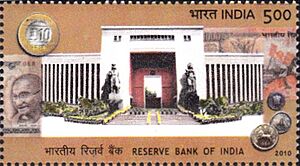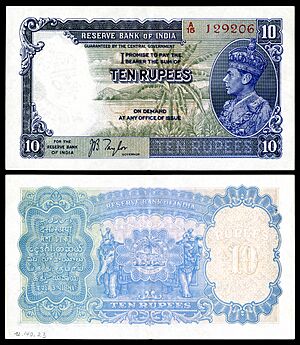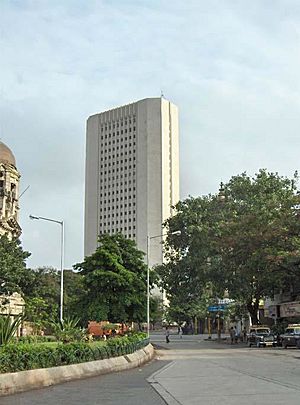Reserve Bank of India facts for kids
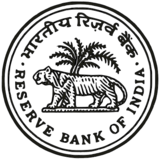 Seal of the Reserve Bank of India 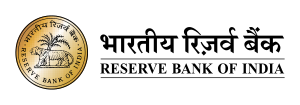 Logo of the Reserve Bank of India 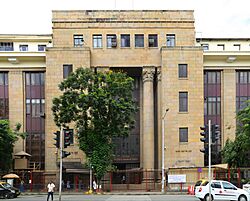 The RBI Tower in Mumbai, which serves as the RBI's headquarters |
|
| Headquarters | Mumbai, Maharashtra, India |
|---|---|
| Coordinates | 18°56′00″N 72°50′11″E / 18.93324°N 72.83646°E |
| Established | 1 April 1935 |
| Governing body | Central Board of Directors. |
| Governor | Sanjay Malhotra |
| Key people |
|
| Central bank of | |
| Currency | Indian rupee (₹) INR (ISO 4217) |
| Reserves | (as of 31 January 2025[update]) |
| Bank rate | 5.5 %(as of 6 June 2025[update]) |
| Interest on reserves | 3.35% (market determined) |
| Reserve Bank of India | |
| Agency overview | |
| Jurisdiction | Government of India |
| Child agency |
|
| Key document |
|
The Reserve Bank of India, or RBI, is like the main bank for the country of India. It's the central bank that controls how money works in India. The RBI is in charge of the Indian currency and makes sure the banking system is stable.
The Ministry of Finance of the Government of India owns the RBI. This means the government is responsible for it. The RBI prints and manages the Indian rupee. It also handles the main ways people pay for things in India.
The RBI works with other groups to help manage payments in India. It has a special part called Bharatiya Reserve Bank Note Mudran (BRBNM). This part prints Indian currency notes in places like Mysore and Salboni. Another part, the Deposit Insurance and Credit Guarantee Corporation, helps protect money deposited in Indian banks.
The RBI started on April 1, 1935. This was based on a law called the Reserve Bank of India Act, 1934. At first, it was privately owned. But on January 1, 1949, it became fully owned by the government. This happened about a year and a half after India became independent.
A group of 21 people called the central board of directors leads the RBI. This group includes the governor, deputy governors, and other important people. They help make big decisions for the bank. The RBI is also part of international groups that help with money and banking.
Contents
- What the RBI Does
- History of the RBI
- How the RBI is Organized
- RBI Offices and Training
- RBI's Subsidiary Companies
- Main Jobs of the RBI
- How RBI Controls Money (Policy Rates)
- Other Ways RBI Controls Money
- Challenges for Money Policy
- No Charges for RTGS and NEFT =
- RBI Committees
- Virtual Currencies and Fraud =
- RBI Training Centers
- Research Centers
- Financial Institutions Once Part of RBI
- Working with Other Countries
- See also
What the RBI Does
The main goals of the Reserve Bank of India are:
...to control the printing of banknotes and keep money safe. This helps keep India's money system stable. It also helps manage the country's money and credit system for everyone's benefit. The RBI aims to have a modern money policy to handle a growing economy. Its main goal is to keep prices steady while also helping the country grow.
History of the RBI
The idea for the Reserve Bank of India came from recommendations made in 1928. These ideas helped create the Reserve Bank of India Act in 1934. Important thinkers like B. R. Ambedkar suggested having a central bank. They wanted it to manage money and control rising prices.
Ambedkar believed in a stable money system. He also wanted everyone to have fair access to banking services. His ideas still guide India's money policies today.
The Reserve Bank of India was officially set up in 1934. It was first owned by private shareholders. But in 1949, the government took full ownership. Since then, the Ministry of Finance fully owns it.
Early Years (1935–1949)
The RBI started on April 1, 1935. It was created to help with money problems after the First World War. The idea came from a special group called the Hilton Young Commission in 1926. India was the first colony to have its own central bank.
The RBI's first symbol was a lion and a tree. But they changed it to a tiger, which is India's national animal. The RBI's main job is to print money and keep enough reserves. This helps keep India's money stable and manage the country's credit system.
The RBI's main office was first in Calcutta (now Kolkata). It moved to Bombay (now Mumbai) in 1937. The RBI also acted as the central bank for Burma (now Myanmar) until 1947. After India was divided in 1947, the bank also served Pakistan until 1948. The RBI is now the only group allowed to print money in India.
Growth and Changes (1950–1960)
In the 1950s, India's government, led by Prime Minister Jawaharlal Nehru, planned the economy. They focused on farming. The government took control of many private banks. The RBI was then given the job of controlling and supporting these public banks.
Protecting Deposits (1961–1968)
After some banks failed, the RBI was asked to create a system to protect people's deposits. This system started on December 7, 1961. It helped people trust banks again. The government also encouraged more banking and nationalized many financial groups. The RBI became very important in guiding these public banks.
More Nationalization (1969–1984)
In 1969, the government led by Indira Gandhi took over 14 large banks. Later, in 1980, six more banks were nationalized. The government made more rules for the economy and banks. The RBI became a key player, setting rules for interest rates and how much money banks had to keep. These rules helped guide banks to lend money to important areas like farming and small businesses.
Economic Changes (1985–1990)
Many groups studied India's economy in the late 1980s. Their ideas influenced the RBI. New groups were created to help markets work better and protect investors. The RBI also helped create new ways for people to save and invest money.
Opening Up the Economy (1991–1999)
In 1991, India's economy faced challenges. The Indian rupee lost some of its value. Experts suggested making changes to the financial system. New rules in 1993 allowed private banks to start. This helped make the market stronger. The RBI also made some rules about bank interest rates more flexible.
The National Stock Exchange of India started trading in 1994. The RBI also created a company called Bharatiya Reserve Bank Note Mudran Private Limited in 1995. This company helps print banknotes.
New Laws and Growth (2000–2009)
A new law called the Foreign Exchange Management Act, 1999 started in 2000. It helped manage foreign money. In 2006, a new company called the Security Printing & Minting Corporation of India Ltd. was formed. It makes banknotes and coins.
Recent Times (Since 2010)
In 2016, the government changed the RBI Act. They created the Monetary Policy Committee (MPC). This group now helps set interest rates. The RBI governor has a vote in this committee.
The RBI also started issuing Sovereign Gold Bonds in 2016. These bonds let people invest in gold without buying physical gold. This helps reduce how much gold India imports.
In 2018, the RBI said that banks should not deal with virtual currencies like Bitcoin. However, in 2020, the Supreme Court of India said the RBI did not show enough reasons for this ban. The RBI later clarified that it had not completely banned virtual currencies.
How the RBI is Organized
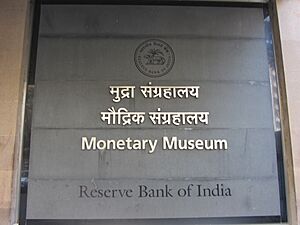
The central board of directors is the main group that leads the RBI. The Government of India chooses these directors for four years. The board includes the governor, up to four deputy governors, and other members. These members come from different fields and represent various regions.
The current governor of the RBI is Sanjay Malhotra. There are also four deputy governors: Swaminathan J, M. Rajeshwar Rao, Michael Patra, and T. Rabi Shankar.
| Level | Who | Headcount | Incumbent | |||||||||||||
|---|---|---|---|---|---|---|---|---|---|---|---|---|---|---|---|---|
| 1 | Central Board of Directors | Multiple |
|
|||||||||||||
| 2 | Governor | 1 | Sanjay Malhotra | |||||||||||||
| 3 | Deputy Governors | 4 | T Rabi Shankar, Swaminathan J, Poonam Gupta and MR Rao. | |||||||||||||
| 4 | Executive Directors | Multiple | ||||||||||||||
| 5 | Principal Chief General Managers | Multiple | ||||||||||||||
| 6 | Chief General Managers | Multiple | ||||||||||||||
| 7 | General Managers | Multiple | ||||||||||||||
| 8 | Deputy General Managers | Multiple | ||||||||||||||
| 9 | Assistant General Managers | Multiple | ||||||||||||||
| 10 | Managers | Multiple | ||||||||||||||
| 11 | Assistant Managers | Multiple | ||||||||||||||
| 12 | Support Staff | Multiple |
RBI Offices and Training
The RBI has four main regional offices: North (New Delhi), South (Chennai), East (Kolkata), and West (Mumbai). These offices help manage regional banking needs.
The RBI has 31 branches across India. Most are in capital cities. Some exceptions include Nagpur and Ahmedabad.
The RBI also has three training colleges for its officers. These are in Chennai, Mumbai, and Pune. It also runs three special institutions for research and development in banking.
RBI's Subsidiary Companies
The RBI has several companies that help it do its work:
Indira Gandhi Institute of Development Research
This is a research center set up by the RBI. It focuses on advanced studies.
Bharatiya Reserve Bank Note Mudran
This company was started in 1995. Its job is to print enough Indian rupee notes for the country.
Deposit Insurance and Credit Guarantee Corporation
This company helps protect money deposited in all Indian banks. It also helps guarantee credit facilities.
Reserve Bank of India Information Technology
This group helps the RBI with its information technology and cybersecurity. It also works to make the Indian banking industry safer from cyber threats.
Indian Financial Technology and Allied Services
This company was set up in 2015. It provides IT services to banks and financial groups in India. It manages important payment systems like Real-Time Gross Settlement (RTGS) and National Electronic Funds Transfer (NEFT).
Reserve Bank of India Innovation Hub
The RBI Innovation Hub (RBIH) started in 2022 in Bengaluru. It aims to encourage new ideas in finance. It especially focuses on helping people with lower incomes get financial services. The RBIH is also working on a plan for a Digital Rupee.
Main Jobs of the RBI
The central bank of any country does many important jobs. These include managing money policy, printing currency, handling foreign money, and acting as a bank for the government. It also helps other banks and works for the country's overall economic growth.
Watching Over Banks
The RBI's main goal is to keep an eye on all parts of the financial world. This includes commercial banks, financial groups, and non-banking finance companies. It makes sure they follow the rules.
A special board called the Board for Financial Supervision (BFS) helps with this. It checks reports and deals with problems. This board also works to improve how banks are audited and controlled.
Rules for the Financial System
The RBI sets the main rules for how banks in India operate. It makes sure people trust the banking system. It also protects people's money and makes banking services easy to use. The RBI controls how much money is available. It also decides the design of rupee banknotes and coins.
The RBI checks banks regularly. It sets rules for new bank licenses and how much money banks must keep.
Managing Payments
The RBI also oversees how payments are made and settled in the country. It makes sure payment systems are safe and efficient. Two important payment systems are National Electronic Fund Transfer (NEFT) and Real-Time Gross Settlement (RTGS). These allow people and companies to send money between banks.
Since December 16, 2019, you can transfer money using NEFT 24 hours a day, every day. RTGS transactions are also processed continuously.
Bank for the Government
Just like people need a bank, the government also needs one. The RBI acts as the bank for the Government of India (GoI). It manages the government's accounts, receives payments, and makes payments. The RBI also helps the government borrow money from the public by issuing bonds.
Handling Foreign Money
The RBI manages India's foreign money. Its goal is to make international trade and payments easier. It also helps keep the foreign exchange market stable.
The RBI holds the country's reserves of international money and gold. This helps India deal with money problems related to international trade. The RBI also buys or sells foreign money to keep exchange rates steady.
Printing Money
The Reserve Bank of India is the only group allowed to print banknotes in India. The Government of India prints one rupee notes and mints coins. The RBI helps distribute and handle these.
The RBI also destroys old banknotes that are no longer good to use. All the money printed by the RBI is backed by assets. This helps people trust the paper money. The RBI aims to provide enough banknotes and keep the money system working well.
The RBI has four places where notes are printed:
- The Security Printing and Minting Corporation of India Limited (SPMCIL) has presses in Nashik and Dewas.
- The Bharatiya Reserve Bank Note Mudran Private Limited (BRBNMPL), owned by the RBI, has presses in Mysore and Salboni.
For coins, SPMCIL has four mints in Mumbai, Noida, Kolkata, and Hyderabad. The RBI also works to stop fake currency by adding new security features to notes.
The RBI can print notes up to ₹10,000 and mint coins up to ₹1,000. New ₹500 and ₹2,000 notes were issued in November 2016. Old ₹1,000 and ₹500 notes were stopped from use then. On May 19, 2023, the RBI announced that ₹2,000 notes would be removed from circulation. This was part of a "Clean Note Policy" to keep currency efficient.
Bank for Other Banks
The RBI also acts as a bank for other commercial banks. These banks have accounts with the RBI and can deposit money there. The RBI helps clear cheques between banks and transfer funds. It can also lend money to banks when they need it. It acts as the "lender of last resort" by giving emergency loans to banks.
Finding Fake Money
The RBI works to find and stop fake currency. In 2014, the RBI announced it would remove all banknotes printed before 2005. People had to exchange these notes at banks. This helped find black money and reduce fake currency because newer notes have better security features.
Helping Development
The RBI also has a role in helping the country grow. It supports national goals and industries. For example, it encourages banks to lend money to important areas like farming, small businesses, housing, and education. The RBI also helps small local banks and encourages banks to open branches in rural areas. This helps more people get access to banking.
Keeping Foreign Money Safe
The RBI keeps the country's international currency reserves safe. This helps India deal with problems related to its balance of payments.
Central Securities Depository for Government Bonds
The Public Debt Office (PDO) acts as a central place for government bonds.
How RBI Controls Money (Policy Rates)
| Policy rates | |
|---|---|
| Policy repo rate | 6.0% |
| Reverse repo rate | 3.35% |
| Marginal standing facility rate | 6.25% |
| Bank rate | 6.25% |
| Reserve ratios | |
| Cash reserve ratio (CRR) | 4.0% |
| Statutory liquidity ratio (SLR) | 18.00% |
| Lending and deposit rates | |
| Base rate | 8.85%–10.10% |
| Marginal cost of funds-based overnight lending rate (MCLR) | 7.95%–8.35% |
| Savings deposit rate | 2.70%–3.00% |
| Term deposit rate for > 1 year | 6.00%–7.25% |
Repo Rate
The repo rate is the interest rate at which the RBI lends money to other banks for a short time. If the RBI wants to make it more expensive for banks to borrow, it raises the repo rate. This makes loans more expensive for everyone. If the RBI wants to make borrowing cheaper, it lowers the repo rate. This helps the economy grow.
Banks have to offer government bonds as security when they borrow from the RBI. This is part of a "repurchase agreement."
If prices are rising too fast (inflation), the RBI increases the repo rate. This makes borrowing more costly for banks and their customers. Fewer people take loans, which helps bring prices down. The RBI does the opposite if prices are falling (deflation).
Reverse Repo Rate (RRR)
The reverse repo rate is the opposite of the repo rate. It's the interest rate the RBI pays to banks when they deposit their extra money with the RBI. The RBI uses this when there's too much money in the banking system.
If the reverse repo rate goes up, banks earn more by keeping their money with the RBI. This makes them less likely to lend money to others, which is riskier. The reverse repo rate helps the RBI take extra money out of the banking system.
Statutory Liquidity Ratio (SLR)
Banks must keep a certain amount of their money in liquid assets. These include gold, cash, and approved government bonds. A higher SLR means banks have less money to lend. This helps control inflation. It also means banks invest more in government bonds.
Bank Rate
The bank rate is the interest rate the RBI charges banks for long-term loans. It's currently 6.25%. If a bank doesn't meet certain requirements, the RBI can charge them a penalty based on the bank rate.
Liquidity Adjustment Facility (LAF)
The LAF was started in 2000. It helps banks borrow money from the RBI or deposit extra funds with the RBI overnight. Banks use government bonds as security for these transactions.
Cash Reserve Ratio (CRR)
The CRR is the amount of money banks must keep with the RBI as cash. This helps ensure banks have enough money and are stable. The RBI has set the CRR at 4.0%. A small change in CRR can have a big effect on the money in the economy. The RBI does not pay interest on the CRR.
If the RBI wants to control rising prices, it can increase the CRR. This leaves banks with less money to lend. Banks then have to raise their interest rates, making borrowing more expensive. This reduces overall demand and helps bring prices down.
Open Market Operations (OMO)
OMO is when the RBI buys or sells government bonds in the open market. This helps control how much money is in the banking system. If there's too much money, the RBI sells bonds to take money out. If there's not enough money, the RBI buys bonds to put money into the economy.
In March 2020, the RBI put a lot of money into the economy by buying government bonds. This was to help during the COVID-19 pandemic in India concerns.
Marginal Standing Facility (MSF)
This scheme started in 2011. Banks can borrow money from the RBI overnight using this facility. They can use government bonds from their SLR quota as security. This means banks won't get penalized even if their SLR goes a bit lower. The MSF rate is currently 4.25%.
Other Ways RBI Controls Money
Margin Requirements
This is about how much money a bank can lend compared to the value of what's being bought. For example, if you buy a car worth ₹1 million and the loan-to-value (LTV) is 70%, you can borrow up to ₹700,000. The RBI can change this ratio to control how much money banks lend.
Selective Credit Control
The RBI can tell banks not to lend money for certain things. For example, it might tell banks not to lend to traders of specific goods like sugar or cooking oil. This stops people from using bank money to hoard goods and drive up prices.
Moral Suasion
This is when the RBI tries to convince banks to do certain things. It might hold meetings or talk through the media. For example, if the RBI lowers the repo rate, it might ask banks to lower their own lending rates too. It also asks banks to reduce bad loans.
Challenges for Money Policy
In countries like India, money policy doesn't always work quickly. This is because:
- Many people don't use other ways to invest their money. They still rely on savings accounts. So, what the RBI does might not affect them much.
- Many people in rural areas don't use banks. So, RBI's actions don't affect their money activities.
- Weather problems can affect food production. This can cause food prices to rise. Money policy can't directly fix food inflation.
No Charges for RTGS and NEFT =
The RBI decided to remove charges for using RTGS and NEFT. This makes it free to transfer money electronically.
RBI Committees
KV Kamath Committee
In August 2020, the RBI created a committee led by KV Kamath. This group looked at how to help businesses and people who had trouble paying back loans because of COVID-19. They suggested ways to restructure loans up to ₹150 billion.
Virtual Currencies and Fraud =
In April 2018, the RBI told banks not to support crypto transactions. This was because of fraud cases. However, the Supreme Court removed this ban in March 2020. The court said that cryptocurrencies were not illegal, even if they weren't regulated.
As of June 30, 2025, the RBI has told banks to use a tool called the Financial Fraud Risk Indicator (FRI). This tool helps banks find mobile numbers linked to fraud. It helps prevent online financial scams.
RBI Training Centers
- Reserve Bank Staff College, Chennai
- Reserve Bank of India Academy, Mumbai
- Reserve Bank of India College of Agricultural Banking, Pune
These three colleges train officers for the Reserve Bank of India and the banking industry.
Research Centers
- National Institute of Bank Management
- Institute for Development and Research in Banking Technology
- Indira Gandhi Institute of Development Research
Financial Institutions Once Part of RBI
Some important financial groups that used to be part of the RBI are now separate:
- Export-Import Bank of India
- National Bank for Agriculture and Rural Development
- Small Industries Development Bank of India
- National Housing Bank
Working with Other Countries
Project Nexus
On June 30, 2024, the Bank for International Settlements and several central banks, including the Reserve Bank of India, started Project Nexus. This project aims to make it easier to send money across borders for everyday payments. The goal is to connect different countries' fast payment systems by 2026.
See also
 In Spanish: Banco de la Reserva de la India para niños
In Spanish: Banco de la Reserva de la India para niños
- Inflation in India
- Financial risk management
- Risk management
- Consumer leverage ratio
- Core inflation
- Open market operation
- Dot-com bubble
- 2008 financial crisis
- Free banking
- Gold standard
- Government debt
- Digital rupee
- Cost-of-living index
- Wholesale price index
- Consumer price index
- Sovereign Gold Bond
- Outline of economics
- List of central banks
- Exchange rate history of the Indian rupee
- List of governors of the Reserve Bank of India
- List of deputy governors of the Reserve Bank of India


